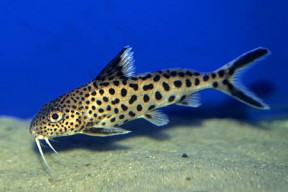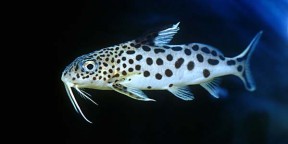Synodontis multipunctata
Cuckoo Synodontis
Classification
Mochokidae
Distribution
This species is endemic to Lake Tanganyika.
Habitat
This species is endemic to Lake Tanganyika.
Maximum Standard Length
Usually around 6″ (15cm) in aquaria but has been recorded up to in nature.
Aquarium SizeTop ↑
48″ x 12″ x 12″ (120x30x30cm) – 110 litres minimum as it should be kept in a group.
Maintenance
Should be housed in a Lake Tanganyika biotope setup, with piles of rocks arranged to form caves and areas of open water for swimming. Dim lighting will encourage the fish to be seen more often.
Water Conditions
Temperature: 75 to 82°F (24 to 28°C)
pH: 7.5-8.5
Hardness: 15-35 dH
Diet
Synodontis are omnivorous and are most unfussy in terms of feeding. Frozen, live and dried foods are all accepted. It also relishes vegetable matter in the form of shelled peas, cucumber etc., which it will rasp at with the teeth in its lower jaw.
Behaviour and CompatibilityTop ↑
Should not be kept with any fish so small as to be considered food but makes a good addition to a community of hard water cichlids, ideally mouthbrooding species of Rift Lake origin. It should be kept in a group of four or more, as single specimens are often very secretive.
Sexual Dimorphism
Mature females are plumper than males. Male fish also have a higher, more pointed dorsal fin. It can also be sexed by examining the genital papillae. This is not for the amateur however. The fish should be held ventral side up in the palm of your hand. The dorsal fin should be taken between your middle and ring fingers in order to avoid being pierced by the sharp dorsal fin rays. The genital area you are looking for is concealed beneath the pelvic fins. This can be exposed by pulling (gently) on the caudal fin. A male fish will exhibit an extended papillae which should be pointed and ridged. The spermatoduct can be seen on the caudal side. Females also have a clearly visible papillae but this is more rounded and the oviduct is on the opposite side to the male’s spermatoduct. Most species of medium/large Synodontis can be sexed using this method but it should be noted that most species take 2 years or more to reach sexual maturity.
Reproduction
Unlike the majority of the genus, S. multipunctata is actually bred quite often in aquaria and provides a fascinating insight into a unique breeding strategy to the fishkeeper lucky enough to witness a spawning. It is one of the only fish known to exhibit a method of spawning known as brood parasitism, the others also being Tanganyikan Synodontis species! The catfish times its spawning to coincide with that of a ‘host’ mouthbrooding cichlid and lays its eggs among those of the host fish. The Syno eggs hatch much quicker than the cichlids’ and the young catfish quickly devour all the mouthbrooder’s eggs. The unwitting cichlid then guards the fry as if they are their own.
This can be achieved in aquaria relatively easily. First a breeding aquarium must be set up as if there are other species in the tank the Syno eggs may also be eaten! This should contain piles of rocks or caves in the form of terracotta pots but should be simpler in design than a standard Tanganyikan tank. This is because the adult fish will need to be removed after spawning. A suitable host species must be chosen. Good choices are small Haplochromine cichlids of Lakes Victoria or Malawi (see below). Both sets of fish should then be brought into condition on a diet of live and frozen foods and the water must be kept very clean with minimal nitrates.
The male will keep a close eye on the behaviour of the cichlids and when breeding behaviour is exhibited, will go and collect the female. If she accepts the situation as suitable, some chasing between the catfish will occur as they wait for the cichlids to lay their eggs. As soon as the cichlids begin spawning, the catfish will rush in and deposit their own eggs and sperm, whilst often eating as many cichlid eggs as they can. This may happen several times, as the male cichlid will usually defend the spawning site vigorously.
Once the cichlids have finished their own spawning the female cichlid will pick up all the eggs, including those of the catfish, to mouthbrood them. At this point, the adult catfish can be removed. The Syno eggs typically hatch in 3 days or so and their first food is the cichlid eggs and any early-hatching cichlid fry. Once they have been released from the mouth of the unwitting mother cichlid, the hosts can also be removed. The fry feed voraciously on brine shrimp nauplii until they are big enough to accept larger food items.
Breeding in aquaria has also been recorded in the absence of a host species, although it is uncommon. This is also likely to occur in nature (see below).
NotesTop ↑
The reason we have recommended the use of non-Tanganyikan cichlid hosts above is because a successful captive spawning using Tanganyikan cichlid species has never been recorded! This may be due to an evolutionary process that has been observed in the lake, in which many cichlid species appear to have learned to avoid S. multipunctata when breeding. This is similar to the rejection of alien eggs by the host species in brood-parasatising birds. Because no species of brood parasatising catfish occur in either Lake Malawi or Victoria, species from these lakes make ideal host fish in aquaria, as they have no learned response to the presence of S. multipunctata when spawning.
As mentioned above, S. multipunctata does not necessarily require that its eggs are mouthbrooded by another species, as captive spawnings have occured when no host fish was present. It seems likely that this also occurs in the lake in nature, as the population size of this species is large, and during brood parasitism, relatively few eggs are deposited successfully. A female S. multipunctata is also capable of producing several hundred eggs, but in surveys, relatively few mouthbrooding cichlids were found to be carrying catfish eggs. When considered with the facts above regarding learned behaviour in cichlids, it makes sense to suppose that this species also spawns openly, as with many other Synos.
A stunning species found swimming in large shoals in its natural habitat. Many individuals offered for sale today are captive bred.
Also referred to as the Many-spotted Synodontis.



